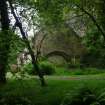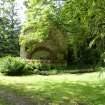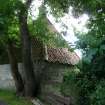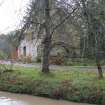Buildings at Risk Register Paused
Following the review of the Buildings at Risk Register the decision has been taken to pause the BARR in order to consider long-term options for its future.
The existing BARR website will remain accessible as a resource, however it will not be updated and we're not accepting nominations for additions to the Register.
Law Mill, Lade Braes, St Andrews
Ordnance Survey licence number AC0000807262. All rights reserved. © Copyright and database right 2025. Public Sector Viewing Terms
Useful Links
- NRHE:
- ST ANDREWS, LAW MILL
- Historic Scotland:
- HS Reference No 40930
General Details and Location
Category
AT RISK
Name of Building
Law Mill
Other Name(s)
Address
Lade Braes, St Andrews
Locality
Postcode
Planning Authority
Divisional Area
Reference No
4929
Listing Category
C
OS Grid Ref
NO 49226 15806
Location Type
Urban
HS Reference No
40930
Description
Predominantly roofless former mill on sloping site incorporating kiln with distinctive pyramid roof forming T-plan and associated late to later 19th century cottage. Sandstone rubble to mill with some ashlar margins. Squared and snecked sandstone with ashlar margins to single story and attic 3-bay cottage. LAW MILL: E elevation partly ruinous with near-central section of wall missing, probably formerly cart arches. Segmental arched entrance with dated keystone to right. Eaves level loft opening to far right. Fragmentary remains of further buildings to S. Wheel-pit to N elevation with cast-iron outer frame of wheel and some remainder of mechanism to interior. Square-plan kiln with pantiled pyramid roof projects from W elevation.
Law Mill, with its associated cottage, is a rare survivor of the many mills that once operated in this area. Law Mill was a corn Mill and its distinctive pantiled kiln is a particular striking feature. The first written record of a mill on this site is from 1570 when it was feued to David Orme of Priorletham by the Priory of St Andrews. It is possible that a mill has occupied this site since the 13th century (M Jarron & J Webster). The origin of the name "Law" is believed to be the Anglo Saxon word "hlaw", a burial mound most likely to be the nearby Hallow Hill (R N Smart, p 180). Law Mill was noted as being unusual by 1660 for being a double mill, denoting that it contained two sets of grinding stones. The mill was feued to Thomas Nicoll in 1848 and was to fall into decline from this period; the Nicoll family declared bankruptcy in 1913 after milling had stopped. The initials T N (Thomas Nicoll) can be found inscribed to the right side of the segmental arched opening to the Mill. Law Mill had an important part to play in the development of the Lade Braes walk as a designed landscape. The Lade Braes name derives from hillside (braes) and a course of water (lade) denoting the course built, initially by the Priory of St Andrews in the 13th century, to divert the water from the Kinness Burn to the many mills that once existed in the area. The Law Mill initially drew water from the Lumbo Burn before 1843 and after this date the diverted waters of the Kiness Burn were also used. (Historic Scotland)
Law Mill, with its associated cottage, is a rare survivor of the many mills that once operated in this area. Law Mill was a corn Mill and its distinctive pantiled kiln is a particular striking feature. The first written record of a mill on this site is from 1570 when it was feued to David Orme of Priorletham by the Priory of St Andrews. It is possible that a mill has occupied this site since the 13th century (M Jarron & J Webster). The origin of the name "Law" is believed to be the Anglo Saxon word "hlaw", a burial mound most likely to be the nearby Hallow Hill (R N Smart, p 180). Law Mill was noted as being unusual by 1660 for being a double mill, denoting that it contained two sets of grinding stones. The mill was feued to Thomas Nicoll in 1848 and was to fall into decline from this period; the Nicoll family declared bankruptcy in 1913 after milling had stopped. The initials T N (Thomas Nicoll) can be found inscribed to the right side of the segmental arched opening to the Mill. Law Mill had an important part to play in the development of the Lade Braes walk as a designed landscape. The Lade Braes name derives from hillside (braes) and a course of water (lade) denoting the course built, initially by the Priory of St Andrews in the 13th century, to divert the water from the Kinness Burn to the many mills that once existed in the area. The Law Mill initially drew water from the Lumbo Burn before 1843 and after this date the diverted waters of the Kiness Burn were also used. (Historic Scotland)
Building Dates
Dated 1757
Architects
Unknown
Category of Risk and Development History
Condition
Very Poor
Category of Risk
Low
Exemptions to State of Risk
Law Mill Cottage is not at risk and is excluded from this entry.
Field Visits
22/11/2010, 15/7/2014, 13/6/2019
Development History
15 July 2014: External inspection finds the building remains in much the same condition as seen previously with vegetation encroaching wallheads.
13 June 2019: External inspection finds the building remains in much the same condition as seen previously, subject to gradual decline, notably to the roof. Vegetation growth is increasing.
3 May 2024: The property is being marketed for sale as potential development project by appointed agent, Rollos. The property is marketed along with Lawmill Cottage, at offers over £850,000.
Guides to Development
Conservation Area
Hepburn Gardens, St Andrews
Planning Authority Contact
PAC Telephone Number
Availability
Current Availability
Unknown
Appointed Agents
Price
Occupancy
Vacant
Occupancy Type
N/A
Present/Former Uses
Name of Owners
Unverified see FAQ on ascertaining ownership
Type of Ownership
Unknown
Information Services
Additional Contacts/Information Source
Bibliography
Online Resources
Classification
Food and Drink Processing
Original Entry Date
18-MAY-11
Date of Last Edit
19/12/2014












